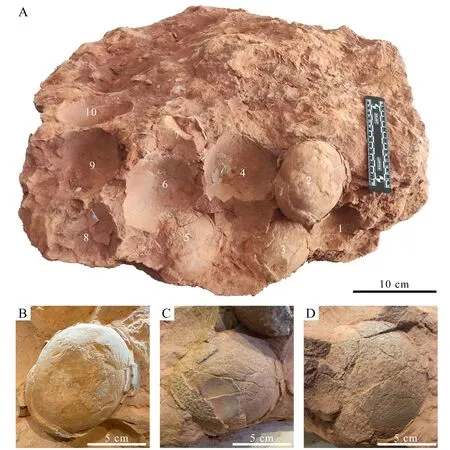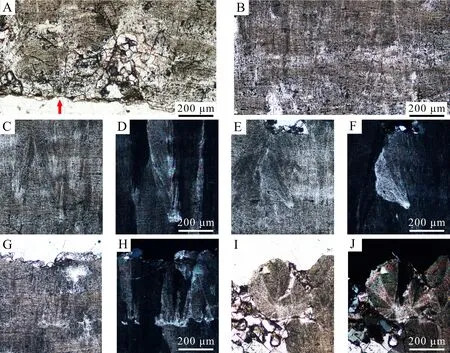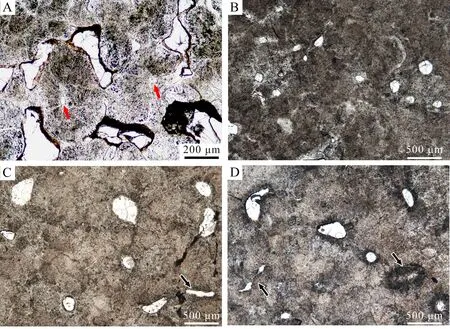An egg clutch of the Stalicoolithidae discovered in Wuning,Jiangxi,China
ZHOU Ming-Xiao YAN Yun QIU Wen-Jiang FANG Kai-Yong ZHU Xu-Feng WANG Qiang* WANG Xiao-Lin,6
(1 Key Laboratory of Vertebrate Evolution and Human Origins of Chinese Academy of Sciences,Institute of Vertebrate Paleontology and Paleoanthropology,Chinese Academy of Sciences Beijing 100044)
(2 University of Chinese Academy of Sciences Beijing 100049)
(3 Wuning County Museum Wuning,Jiangxi 332300)
(4 Basic Geological Survey Institute of Jiangxi Geological Survey and Exploration Institute Nanchang 330030)
(5 National Natural History Museum of China Beijing 100050)
(6 Centre for Research and Education on Biological Evolution and Environment,Nanjing University Nanjing 210023)
Abstract Here we describe an incomplete dinosaur clutch with three broken eggs and seven prints discovered in Wuning County,Jiangxi Province,that can be referred to Coralloidoolithus shizuiwanensis based on the following features: the eggs are nearly spheroid and arranged tightly and irregularly in the clutch,the eggshell thickness ranges 2.76-2.97 mm,the horizontal accretion lines are almost evenly distributed throughout the eggshell,and the secondary eggshell units are distributed in the medial and outer zones of the columnar layer.This egg clutch of Coralloidoolithus shizuiwanensis represents the first discovery of dinosaur eggs in Wuning County,and shows the age of the strata containing the dinosaur eggs in this area should be Late Cretaceous.
Key words Wuning County,Jiangxi Province;Late Cretaceous;dinosaur eggs;Stalicoolithidae
1 Introduction
In October 2022,a clutch of dinosaur eggs was found at a construction site in the Duxi Village,Luoping Town,Wuning County,Jiangxi Province (Fig.1).The lithology of the outcrop is mainly polymict conglomerate (conglomerate and fine sandstone) and the dip direction and dip angle of the stratum are 320° and 8° respectively.The Jiangxi Geology and Mineral Exploration and Development Bureau (2017) attributed the strata to the Paleogene Moxia Formation of the Wuning Group as piedmont pluvial facies.The Moxia Formation was named by the Department of Geology and Mineral Resources of the Jiangxi Province (1997) according to the Moxia-Wangbu stratotype section in Wuning County.The lower and upper parts of the Moxia Formation are composed of purplish-red thick layered polymict conglomerate and pebbly sandstone.The middle part (Wangbu limestone member) is composed of grey,purplish medium-thick layered cryptocrystalline limestone and pebbly cryptocrystalline limestone.The determination of its age mainly relies on the paleontological assemblage in the Wangbu limestone member,while there is little evidence that can be used to infer the geological age of the lower and upper parts of the Moxia Formation.In recent years,with the further study of the red beds in southern Jiangxi,the lithology assemblage has been found to be more in line with the characteristics of the Upper Cretaceous Lianhe Formation,Guifeng Group (Jiangxi Geology and Mineral Exploration and Development Bureau,2017).This paper describes the dinosaur eggs found in Wuning and provides paleontological evidence for the geological age of the strata.

Fig.1 The incomplete clutch of Coralloidoolithus shizuiwanensis (WNCM-V1) from Wuning,Jiangxi
2 Materials and methods
The eggshells selected for microscopic sections were cleaned by ultrasonic and embedded in resin.Then they were cut and grinded by using EXAKT 300CP slicer and EXAKT 400CS grinder to slices approximately 30 μm thick.The eggshell slices were observed and photographed under a polarizing microscope.The eggshell experiments were performed in the Key Laboratory of Vertebrate Evolution and Human Origins,Chinese Academy of Sciences.
3 Systematic paleontology
Stalicoolithidae Wang et al.,2012
Coralloidoolithus Wang et al.,2012
Coralloidoolithus shizuiwanensis (Fang et al.,1998) Wang et al.,2012
New referred specimensWNCM-V1,an incomplete clutch,with eggshell radial and tangential sections S221008-1①-②,S221008-2①-④,housed at Wuning County Museum.
Locality and horizonDuxi Village,Luoping Town,Wuning County,Jiangxi Province;Upper Cretaceous.
DiagnosisThe eggs are nearly spheroid and arranged tightly and irregularly in the clutch.The thickness of the eggshell ranges from 2.76-2.97 mm.The eggshell can be divided into a cone layer and columnar layer.The thickness of the cone layer ranges from 0.22-0.32 mm,which is about 1/10 of the eggshell thickness.There are around 23-26 cones per a square millimeter.The columnar layer can be divided into inner,medial and outer zones.Secondary eggshell units are distributed in the medial and outer zones.A relatively large number of secondary shell units are distributed in the columnar layer,and most of the secondary eggshell units in the outer zone are closely arranged.Horizontal accretion lines are evenly distributed throughout the eggshell.The pores are irregular and worm-like.
DescriptionAn incomplete clutch consisting of three broken eggs and seven prints with a few eggshell remnants.The eggs were arranged tightly and irregularly in the clutch (Fig.1).Egg No.2 is nearly spheroid in shape,106 mm × 86 mm.The outer surfaces are rough and covered with sediment.
In the radial section (Fig.2),the thickness of the eggshell ranges from 2.76-2.97 mm,but it may not reach its original thickness due to weathering.The eggshell microstructure shows closely arranged eggshell units.The boundary between the cone layer and columnar layer is not clear.The eggshell units show radial extinction through the nucleation centers to the outer surface under cross-polarized light.The pore canals are irregular and worm-like.

Fig.2 Microstructure of the Coralloidoolithus shizuiwanensis in radial section (S221008-1②)under ordinary light (A) and cross-polarized light (B)White lines show the boundaries between the inner,medial and outer zones
The cone layer is thin and ranges from 0.22-0.32 mm in thickness,about 1/10 of the eggshell thickness.In the radial section,the gaps between the cones are significant (Fig.2),but some cones are incomplete due to weathering.The accretion lines are concentric arcs around the nucleation centers (Fig.3A).In the tangential section,the cones show a radial microstructure surrounding the nucleation centers (Fig.4A),and the density of the cones is 23-26 per a square millimeter.The pores are irregular in shape and vary in size (Fig.4A).

Fig.3 Microstructure of the Coralloidoolithus shizuiwanensis in radial section

Fig.4 Microstructure of the Coralloidoolithus shizuiwanensis in tangential section
The columnar layer is thick,ranges 2.38-2.72 mm in thickness,and can be divided into three zones.The boundary between the inner zone and the medial zone is not obvious.The accretion lines are dark in color and evenly distributed in the columnar layer.The inner zone ranges from 0.78-0.92 mm thick,which is about 1/3 of the eggshell thickness.In the radial section,the gaps between eggshell units tend to be closed (Figs.2,3B).In the tangential section,the pores are nearly round (Fig.4B).
The medial zone ranges from 1.15-1.30 mm thick,which is about 2/5 of the eggshell thickness.In the radial section,the eggshell units are tightly arranged with no obvious gaps(Figs.2,3C-F).The upper part of this zone is distributed with multiple discontinuous lightcolored stripes (Fig.2).This zone distributes secondary eggshell units with two different shapes: conical (Fig.3C,D) and fan-shape (Fig.3E,F).In the tangential section,the pores are either nearly round,sickle-shape or nearly closed (Fig.4C).
The outer zone distributes closely arranged secondary eggshell units,and its outer surface greatly undulates due to weathering (Fig.2).In the radial section,the secondary eggshell units show independent extinction under cross-polarized light (Fig.3G,H).The secondary eggshell units surrounding the pore openings are large and circular,have radial microstructures that are similar to those of the cones,and show fan-shaped extinction under cross-polarized light (Fig.3I,J).In the tangential section,a greater number of the pores are closed or nearly closed (Fig.4D).
4 Comparison and discussion
The eggs found in Wuning are nearly spheroid with rough surfaces.In regard to the eggshell microstructure,the eggshell can be divided into a cone layer and columnar layer,the eggshell units are tightly arranged and highly fused in the columnar layer,the cones are round,and the pores are irregular and worm-like,which can be compared with the oofamily Stalicoolithidae (Wang et al.,2012;Zhao et al.,2015) andParaspheroolithus(Yang,1965;Zhao and Jiang,1974;Zhao et al.,2015).These eggs are distinct from the oogenusParaspheroolithus,with a greater eggshell thickness and secondary eggshell units in the columnar layer (Zhao,1979;Zhao et al.,2015).
Three oogenera,including four oospecies (Stalicoolithus shifengensis,Coralloidoolithus shizuiwanensis,ShixingoolithuserbeniandSh.qianshanensis),are established in the Stalicoolithidae (Zhao et al.,1991;Wang et al.,2012;He et al.,2022).Comparing the eggshell microstructures,the outer zone of the eggshell distributing numerous secondary eggshell units,and the cone layer thickness (0.22-0.32 mm) and cones density (23-26/mm2) of these eggs are close to that ofStalicoolithus shifengensis(0.20-0.25 mm,23-26/mm2,respectively,Wang et al.,2012);but the eggshell thickness (3.50-4.00 mm) ofS.shifengensis(Wang et al.,2012,Zhu et al.,2019) is significantly thicker than that of these eggs,which leads to a significant difference in the thickness ratio of the cone layer to the total eggshell.The accretion lines are slim or invisible in the medial zone ofS.shifengensis,forming a bright-colored strip,unlike the evenly distributed accretion lines of equal thickness seen in the eggs from Wuning.Comparing these eggs with those of the oogenusShixingoolithusis limited to the cone layer and the inner and medial zones of the columnar layer,due to the fact that all the outermost parts of the eggshell are weathered in both the holotype and referred materials ofShixingoolithus erbeni(Zhao et al.,1991,2015;Fang et al.,1998,2009a,b) andSh.qianshanensis(He et al.,2022).The thickness ratio of the cone layer to total eggshell (1/10) of the eggs from Wuning is smaller than inSh.erbeni(1/4,Zhao et al.,1991) andSh.qianshanensis(1/7,He et al.,2022),and the secondary eggshell units are much more developed in these eggs than in the oogenusShixingoolithus.The columnar layer ofShixingoolithusdistributes significantly fewer secondary eggshell units than those ofStalicoolithusandCoralloidoolithus.Considering that the secondary eggshell units are easily weathered,it is uncertain whether there is an outer zone composed of secondary eggshell units present inShixingoolithus.
Compared toCoralloidoolithusshizuiwanensis,which was discovered in Xixia and Xichuan of Henan Province (Fang et al.,1998;Zhao and Zhao,1998;Wang et al.,2012;Zhao et al.,2015),in Tiantai of Zhejiang Province (Fang et al.,2000,2003;Wang et al.,2012;Barta et al.,2013;Zhao et al.,2015),and in Shanggao of Jiangxi Province (Fang et al.,2022),the eggs in Wuning have a similar cone density,thickness ratio of cone layer to total eggshell,and closely arranged secondary eggshell units.Therefore,these eggs can be assigned toCoralloidoolithusshizuiwanensis.The newly discovered eggs have a slightly greater thickness,which expands the thickness range ofC.shizuiwanensis.The horizontal accretion lines are almost evenly distributed throughout the eggshells of the Wuning specimens,while the horizontal accretion lines are poorly developed in the medial and outer zones,which are filled with dark materials in the eggshells from Shanggao (Fang et al.,2022).This may represent differences in the preservation conditions of the specimens.Therefore,when classifying and comparing dinosaur eggs,it is necessary to fully consider the eggshell formation mechanism and the possible impact of later diagenesis.
5 Conclusion
These dinosaur eggs discovered from Wuning County,Jiangxi Province,could be referred to the Stalicoolithidae based on their shape and size,pore shape,cone shape,and the presence of secondary eggshell units in the columnar layer,and toCoralloidoolithusshizuiwanensisbased on the ratio of cone layer to total eggshell thickness,evenly distributed accretion lines,and the closely arranged secondary eggshell units in the outer zone.
This clutch ofCoralloidoolithusshizuiwanensisrepresents the first discovery of dinosaur eggs in Wuning County,which enriches the palaeogeographical distribution of the oogenusCoralloidoolithus,and provides paleontological evidence for the comparison of the strata of the basin containing dinosaur eggs in Jiangxi Province.Also,it confirms the age of the strata containing the dinosaur eggs in this area to be Late Cretaceous.However,further works are required to clarify whether the strata are referred to the Late Cretaceous Lianhe Formation or the age of the Moxia Formation should be revised from Paleogene to Late Cretaceous.
AcknowledgementsThe authors thank Xing Song of the Institute of Vertebrate Paleontology and Paleoanthropology,CAS (IVPP) for providing the specimen discovery information,Liu Yonghong of the IVPP for helping to make the eggshell sections,and Yang Ling of the Jiangxi Museum of Geology for assisting with the field work.
- 古脊椎动物学报(中英文)的其它文章
- New findings of Xiyuichthys (Xiushuiaspidae,Galeaspida)from the Silurian of Jiangxi Province and Tarim Basin
- Reappraisal of Bothriolepis sinensis Chi,1940 from the Tiaomachien Formation,Hunan,China
- A giant bamboo rat from the latest Miocene of Yunnan
- Micromammal fossils from the basal part of the Jiaozigou Formation in Yagou area,Linxia Basin,Gansu Province

